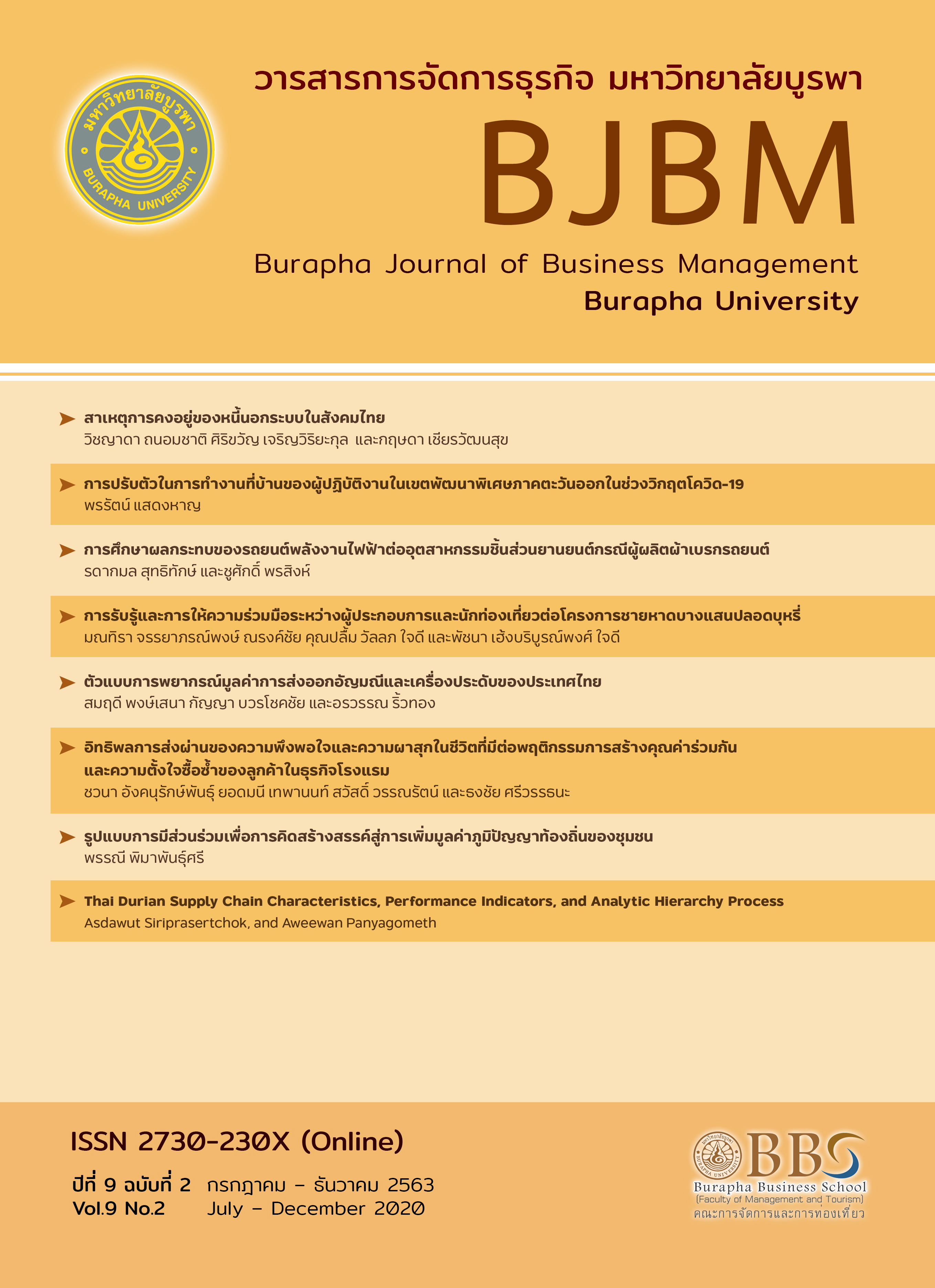การปรับตัวในการทำงานที่บ้านของผู้ปฏิบัติงานในเขตพัฒนาพิเศษภาคตะวันออกในช่วงวิกฤตโควิด-19
Main Article Content
บทคัดย่อ
การวิจัยเรื่องนี้ มีวัตถุประสงค์เพื่อศึกษาถึงการปรับตัวในการทำงานที่บ้าน เปรียบเทียบความแตกต่างของการปรับตัวในการทำงานที่บ้าน โดยจำแนกตามปัจจัยส่วนบุคคล และศึกษาถึงความต้องการของผู้ปฏิบัติงานในการสนับสนุนการทำงานที่บ้านจากองค์กรต้นสังกัด โดยใช้วิธีการวิจัยเชิงสำรวจ สำหรับประชากรที่ศึกษา คือ ผู้ปฏิบัติงานที่ทำงานที่บ้านในเขตพัฒนาพิเศษภาคตะวันออก ในช่วงวิกฤตโควิด-19 มีกลุ่มตัวอย่างที่ตอบแบบสอบถามกลับจำนวน 478 คน ซึ่งผลการวิจัยพบว่าในภาพรวมผู้ตอบแบบสอบถามสามารถปรับตัวในการทำงานที่บ้านได้ในระดับมาก เมื่อพิจารณาเป็นรายด้านพบว่าผู้ตอบแบบสอบถามสามารถปรับตัวได้ในระดับมากทุกด้าน ซึ่งได้แก่ด้านบทบาทหน้าที่ ด้านการพึ่งพาระหว่างกัน ด้านร่างกาย และด้านอัตมโนทัศน์ ตามลำดับ เมื่อเปรียบเทียบการปรับตัวในการทำงานที่บ้าน โดยจำแนกตามปัจจัยส่วนบุคคลพบว่า ผู้ปฏิบัติงานที่มีเพศเจนเนอเรชัน และปฏิบัติงานในประเภทองค์กรที่แตกต่างกัน สามารถปรับตัวในการทำงานที่บ้านได้ไม่แตกต่างกัน แต่ในด้านรูปแบบการทำงานพบว่าผู้ปฏิบัติงานที่ทำงานที่บ้านเต็มเวลากับทำงานที่บ้านบางส่วนเวลามีการปรับตัวแตกต่างกันอย่างมีนัยสำคัญทางสถิติ ส่วนความต้องการของผู้ปฏิบัติงานในการสนับสนุนการทำงานที่บ้านจากองค์กรต้นสังกัด พบว่าผู้ตอบแบบสอบถามส่วนใหญ่ ต้องการให้องค์กรต้นสังกัดสนับสนุนอุปกรณ์ในการทำงาน โดยเฉพาะคอมพิวเตอร์ รองลงมาคือต้องการให้องค์กรสนับสนุนค่าอินเตอร์เน็ท ค่าไฟฟ้าและค่าโทรศัพท์ และต้องการให้องค์กรมีระบบเทคโนโลยีสารสนเทศ เช่น VPN, Platform, Application ที่สนับสนุนการทำงานที่บ้าน ตามลำดับ
Article Details
บทความที่จะตีพิมพ์เพื่อเผยแพร่ในวารสารการจัดการธุรกิจ มหาวิทยาลัยบูรพา จะต้องเป็นบทความที่ไม่เคยได้รับการตีพิมพ์เผยแพร่หรืออยู่ระหว่างการพิจารณาเพื่อตีพิมพ์เผยแพร่ในวารสารอื่น ๆ ทั้งนี้ หากพบว่ามีการละเมิดลิขสิทธิ์ ด้วยข้อคิดเห็นที่ปรากฏและแสดงในเนื้อหาบทความต่าง ๆ ให้ถือว่าเป็นความเห็นและความรับผิดชอบโดยตรงของผู้เขียนบทความนั้น ๆ มิใช่ความเห็นและความรับผิดชอบใด ๆ ของคณะบริหารธุรกิจ มหาวิทยาลัยบูรพา สำหรับในกรณีผู้ประสงค์จะนำข้อความในวารสารการจัดการธุรกิจ มหาวิทยาลัยบูรพา ไปเผยแพร่ต้องได้รับอนุญาตจากกองบรรณาธิการวารสารการจัดการธุรกิจ มหาวิทยาลัยบูรพา ตามกฎหมายว่าด้วยลิขสิทธิ์
เอกสารอ้างอิง
กรมควบคุมโรค. (2563). กรมควบคุมโรค แนะประชาชนเพิ่มระยะห่างทางสังคม “Social Distancing” กับ 8 วิธีป้องกันโรคโควิด-19.
สืบค้นเมื่อ 14 เมษายน 2563, สืบค้นจาก https://ddc.moph.go.th /brc/news.php?news=12278&deptcode=brc.
กระทรวงดิจิทัลเพื่อเศรษฐกิจและสังคม. (2563). คู่มือการปฏิบัติราชการนอกสถานที่. สืบค้นเมื่อ 21 เมษายน 2563, สืบค้นจาก
https://www.onde.go.th/assets/portals/1/files.
เทคซอส. (2563). NIA ชี้เทรนด์ใหม่ Work from Home มีแนวโน้มขยายตัวพร้อมเร่งมาตรการกระตุ้น Startupและ SMEs. สืบค้นเมื่อ 15 เมษายน 2563, สืบค้นจาก https://techsauce.co/pr-news/nia-work-from-home-covid-19#.
รัฐบาลไทย. (2563). สรุปข่าวการประชุมคณะรัฐมนตรี 17 มีนาคม 2563. สืบค้นเมื่อ 14 เมษายน 2563, สืบค้นจาก https://www.thaigov.go.th/news/contents/details/27410.
Allen, T. D., Johnson, R. C., Kiburz, K. M., & Shockley, K. M. (2013). Work–family conflict and
flexible work arrangements: Deconstructing flexibility. Personnel Psychology, 66(2), 345–376.
Bakker, A. B., & Demerouti, E. (2007). The job demands-resources model: State of the art. Journal of managerial psychology, 22(3), 309–328.
Crompton, R. & Harris, F. (1998). Explaining women's employment patterns: `Orientations to work' revisited. British Journal of Sociology. 49,1, 118-136.
Golden, T. D., Veiga, J. F., & Dino, R. N. (2008). The impact of professional isolation on teleworker job performance and turnover intentions: Does time spent teleworking, interacting face- to-face, or having access to communication-enhancing technology matter? Journal of Applied Psychology, 93(6), 1412.
Haddon, L. & Silverstone, R. (1993). Teleworking in the 1990s: A View from the Home. SPRU/CICT Report Series 10, University of Sussex.
Hagqvist, E. (2016). The juggle and struggle of everyday life. Gender, division of work, work–family perceptions and well-being in different policy contexts. Doctoral dissertation, Mid Sweden University.
Hilbrecht, M., Shaw, S. M., Johnson, L. C., & Andrey, J. (2008). ‘I’m home for the kids’: Contradictory implications for work-life balance of teleworking mothers. Gender, Work & Organization, 15(5), 454–476.
Huws, U., Podro, S., Gunnarsson, E., Weijers, T., Arvanitaki, K. & Trova, V. (1996) Teleworking and Gender. Brighton: Institute of Employment Studies.
Johnson, D. (1999). Flexible hours, flexible rules. Home Office Computing,17(7),91.
Robbins, S.P., & M. Coulter. (1999). Management. (6th ed.). New Jersey: Prentice-Hall, Inc.
Roscoe, J. T. (1975). Fundamental research statistics for behavioral sciences. New York: Holt, Rinehart and Winston, Inc.
Roy, Sr. C., & Andrews, H. (1999). The Roy adaptation model (2nd ed.). Stamford: Appleton & Lange.
Shelly, G. B., T. J. Cashman, G. A. Waggoner, & W. C. Waggoner. (1998). Discovering computers 98: A link to the future. USA: Massachusetts.
Sullivan, C., & Lewis, S. (2001). Home-based telework, gender, and the synchronisation of work and family: Perspectives of teleworkers and their co-residents. Gender, Work and Organization, 8(2), 123–145.
Treas, J., & Drobnič, S. (Eds.). (2010). Dividing the domestic: Men, women, and household work in crossnational perspective. Palo Alto: Stanford University Press.
van der Lippe, T. & Lippényi, Z. (2018). Beyond formal access: Organizational context, working from home, and work–family conflict of men and women in European workplaces. Social Indicators Research, 151(2), 383–402.
Wenger, E. (1998). Communities of practice: Learning, meaning, and identity. Cambridge: Cambridge University Press.


